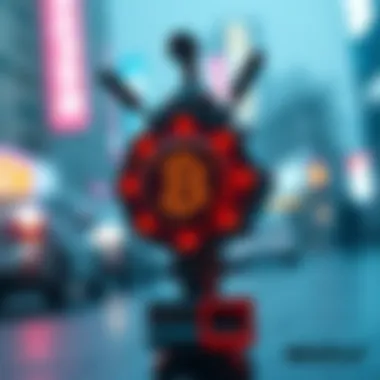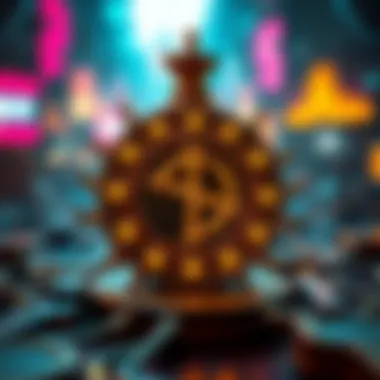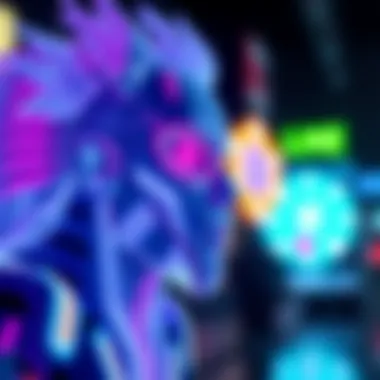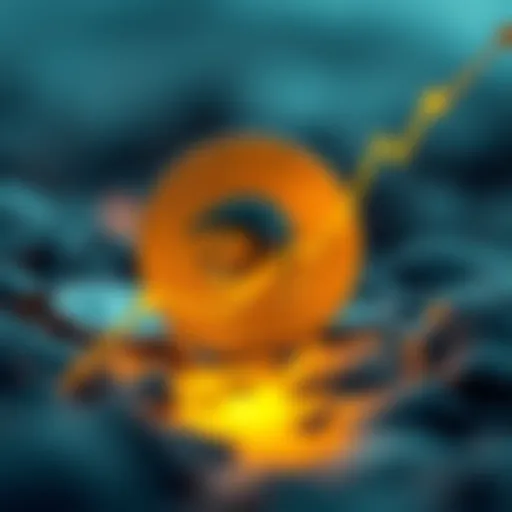Exploring the Evolution of Beeple's NFT Art


Intro
In a world where art and technology intertwine, the rise of digital assets has changed the way we perceive ownership and creativity. Central to this revolution is Mike Winkelmann, better known as Beeple, whose unique approach to art has ushered in a new era for digital creators. His eye-catching works, powered by the principles of non-fungible tokens (NFTs), have not only captivated collectors but also sparked intense discussions about the future of artistic expression and investment in the digital realm.
The phenomenon surrounding Beeple's NFT art serves as a true case study in the evolution of the digital landscape. By examining his journey and the broader implications of his work, we can gain insight into the transformative power of blockchain in contemporary art. Throughout this article, we will explore several key aspects that shape Beeple's influence—from the basics of cryptocurrency to the strategies investors might consider in the ever-evolving art market.
As we delve deeper, we'll uncover the significance of Beeple's contributions and how they reflect larger shifts in the art world. By engaging with these topics, it becomes clear that the intersection of technology and artistic vision is not just a passing trend—it's a pivotal moment reshaping our understanding of art itself. Through this lens, the relevance of Beeple's work becomes increasingly apparent, illuminating the path for other artists and collectors navigating the digital age.
Intro to NFTs and Digital Art
In recent years, the art world has found itself at a pivotal crossroads, largely due to the emergence of Non-Fungible Tokens, or NFTs. This section is crucial as it lays the groundwork for understanding not just the mechanics of NFTs, but also their transformative role in the digital art landscape—an area that has, until recently, been marginalized in favor of traditional forms. Notably, this intersection marks a significant evolution where artists can now secure their work in a way that traditional galleries once monopolized.
One of the main benefits of NFTs is that they provide artists with a direct link to their audience, bypassing the intermediaries that have historically dictated the terms of engagement. Artists are not only able to sell their work as digital assets but also retain ownership rights that ensure they benefit from future sales—something akin to royalties in the physical art market. To fully grasp the weight of these developments, one must recognize the implications for both the creator and the collector.
Furthermore, NFTs challenge long-held perceptions of ownership and authenticity in artistic works. They introduce a new layer of provenance, allowing collectors to verify the originality of a digital piece in a way that was not possible before. This wholesale shift is where the real magic happens, making the understanding of NFTs essential for anyone invested in the present or future of art.
Understanding Non-Fungible Tokens
Non-Fungible Tokens are a type of digital asset that signify ownership of a unique item on a blockchain. Unlike cryptocurrencies such as Bitcoin, which are fungible and interchangeable, NFTs are one-of-a-kind. Each token carries distinct information that makes it irreplaceable. This uniqueness fosters a sense of value that appeals to artists and collectors alike, allowing people to invest in something that cannot be replicated.
The function of NFTs is largely underpinned by blockchain technology, offering a decentralized ledger that records transactions securely. This adds an element of trust, ensuring that all parties can verify the authenticity of a digital artwork. The emergence of platforms like OpenSea and Rarible has further simplified the purchasing process, allowing people from all backgrounds to engage with digital art.
The Rise of Digital Art
Digital art has seen a meteoric rise over the last few decades, evolving from simple graphics on a computer screen to complex multimedia installations. The advent of powerful software tools and platforms has empowered artists, enabling them to push boundaries and redefine what art can be.
As artists flocked online, their creations transitioned from galleries to screens, paving the way for an audience that is far broader than ever before. The global nature of the Internet allows everything from digital paintings to animated images to be shared instantly across the world, creating a cultural melting pot where ideas can flourish.
Moreover, the accessibility of digital platforms has encouraged innovation within the art community. Artists who may once have struggled for recognition within traditional venues now find opportunities online, thus diversifying artistic voices and visions. In tandem with the rise of NFTs, digital art serves as both a reflection and a catalyst for change in the broader art ecosystem.
"The only limit to our realization of tomorrow will be our doubts of today." – Franklin D. Roosevelt
By dissecting the rise of digital art and understanding the role that NFTs play, collectors and investors can better navigate this burgeoning market, enriching their perspectives and engagement with a rapidly changing landscape.
The Role of Beeple in NFT Culture
Beeple, the digital art pseudonym of Mike Winkelmann, represents a seismic shift in the world of art through the lens of non-fungible tokens (NFTs). His emergence in the NFT arena has indelibly transformed how art is perceived, created, and owned in the digital realm. This section elaborates on Beeple's critical role in shaping the culture surrounding NFTs, examining his influence on artists, collectors, and the wider market.
Who is Beeple?
Beeple, born in Charleston, South Carolina, in 1981, is not just any artist. He is a multimedia creator who gained fame through his distinctive style, characterized by vivid imagery and surreal themes. Over the years, he has built a reputation through various avenues, including short films, concert visuals, and motion graphics. But it was in the realm of NFTs that he truly made his mark.
His rise to fame peaked in March 2021 when his piece, "Everydays: The First 5000 Days," sold at auction for a staggering $69 million. This sale catapulted him into the spotlight, making Beeple a household name, not only among art enthusiasts but also in the broader economic landscape.
In many respects, Beeple personifies the modern digital artist, seamlessly blending creativity with technology. His ability to leverage social media platforms has allowed him to amass followers and advocates, paving the way for a new generation of digital creators who look to him as a role model.
Beeple's Artistic Journey
Beeple's artistic journey is a tale marked by persistence and evolution. Long before the world knew him as an NFT pioneer, he was an under-the-radar artist committed to a daily practice he called "Everydays," where he created and shared a piece of art each day without fail for over 13 years. This commitment not only honed his skills but also fostered a dedicated audience—a crucial aspect contributing to his later success in the NFT market.


His work often delves into pressing social issues, with themes ranging from technology’s influence on humanity to the absurdities of modern life. For instance, his pieces frequently incorporate satirical elements of politics and culture, inviting viewers to reflect on uncomfortable truths. For those invested in Beeple's creations, that blend of high art and socio-political commentary provided a compelling reason to engage with his work.
The transition to NFTs was a natural progression for Beeple. Unlike traditional art forms, digital art has the advantage of being easily shared and replicated. However, NFTs endowed his work with a unique quality of ownership—suddenly, collectors could purchase original digital artworks and have verifiable proof of authenticity stored on the blockchain.
"Beeple's work is not just an innovation; it's a statement on the future of art itself—where creativity can be digitally owned and traded just like any physical artifact."
This watershed moment not only raised his profile but also marked a critical turning point for digital artists worldwide. They witnessed firsthand how NFTs could redefine the parameters of artistic value, leading to increased interest and investment in the medium.
In summary, Beeple's influence in the NFT culture cannot be overstated. By reimagining artistic ownership and execution through the lens of blockchain technology, he has challenged and expanded the very definition of art, opening avenues for future creators to explore. This evolution is pivotal as we look ahead to what lies next in this digital art frontier.
Notable Works by Beeple
Beeple, or Mike Winkelmann, is unmistakably one of the most pivotal figures in the NFT art scene. When we talk about his notable works, it isn't just about the art pieces themselves, but the cultural significance they have stirred within the digital art landscape. These pieces have not only showcased his unique vision but have also set benchmarks for the valuation and recognition of digital art in a broader context. By closely examining these works, we gain insight into how Beeple has navigated the intersection of technology and traditional art, making a profound impact on artists, collectors, and enthusiasts alike.
Everydays: The First Days
Concept and Creation
Everydays: The First 5000 Days serves as Beeple's magnum opus in the digital realm. In essence, it is a collage that encapsulates his work from the past 5,000 days, each piece reflecting a snapshot of his artistic evolution. This concept is significant because it transforms the idea of daily practice into a monumental statement about persistence in creativity. The sheer ambition of capturing nearly 14 years of daily artistry in one single piece resonates deeply with audiences. One key characteristic of this work is its commitment to routine; in a world where hustle culture often prevails, Beeple's dedication to crafting something every day paints a picture of unwavering discipline.
The unique feature of this collection lies in its expansive narrative—the journey through various themes, styles, and even societal commentary wrapped up in one digital canvas. Such depth not only enhances its appeal but also allows it to be relatable on multiple levels. For collectors, this work isn't merely about owning a stunning visual; it’s an investment into a piece of art history, symbolizing hard work and creative evolution.
Impact on the Digital Art Market
The impact of Everydays: The First 5000 Days on the digital art market is nothing short of revolutionary. Selling for a staggering $69 million at a Christie’s auction, it became more than just an art piece; it was a clarion call that digital art demands the same respect and valuation as traditional art. This event brought a slew of new collectors into the digital space, reshaping how people perceive and engage with NFTs.
The key characteristic of this impact lies in its broad media coverage, propelling NFTs into mainstream consciousness. The sale demonstrated that digital art can carry significant monetary worth, fostering a new market full of potential. However, this also sparked rampant speculation, leading to a volatile environment where prices could substantially fluctuate. As a double-edged sword, the notoriety gained can fuel both growth and unwarranted risk in investments.
The unique feature here is that it provided a bridge between artists and collectors. For the artist, it legitimized digital formats, while for collectors, it presented an opportunity to partake in something transformative. This has profound implications for the generation of artists who might follow a similar path, encouraging innovation while grappling with the potential pitfalls of a rapidly evolving market.
Collaboration with Other Artists
Beeple's collaboration with other artists marks another crucial aspect of his contribution to the NFT ecosystem. By working alongside various creators, he not only amplifies his own reach but also helps to nurture a culture of collective creativity. In this collaborative landscape, artists can share insights, techniques, and inspiration, contributing to a broader artistic community that thrives on innovation. Collaborations often yield diverse outcomes that diverge from individual styles and visions, allowing for a richer tapestry in digital art. As the NFT space evolves, these partnerships may play a key role in shaping new trends and pushing the boundaries of what digital art can accomplish.
Blockchain Technology and NFTs
Blockchain technology has turned the art world on its head, especially through the emergence of non-fungible tokens (NFTs). It has created a new avenue for artists like Beeple to monetize their digital creations, reshaping the landscape of both art and commerce.
How NFTs Function
At the core of NFT's appeal is their ability to prove ownership and authenticity in a digital context. NFTs are unique digital tokens created on a blockchain, typically Ethereum. Unlike traditional cryptocurrencies, each NFT has distinct attributes that differentiate it from others. This uniqueness fosters a sense of scarcity, appealing to collectors seeking exclusive pieces.
When an artist, such as Beeple, creates an NFT, they embed metadata into the token. This data includes details like the artwork’s creation date, the artist's name, and even links to the digital file itself. Once minted, the NFT is recorded on the blockchain, which acts as an unchangeable ledger, ensuring that only one original copy exists.
This functionality revolutionizes the art market by allowing artists to sell their works directly to consumers without intermediaries, which was not feasible in traditional art forms. When buyers purchase an NFT, they don’t just own a piece of digital art; they possess a verifiable claim on the ownership.
The Importance of Ownership and Provenance


The concept of ownership in the digital world has always been murky. In a universe where files can be copied and shared endlessly, owning art has seemed redundant at best. However, NFTs answer this quandary through blockchain technology. The ownership and transaction history of each NFT is recorded publicly and immutably, ensuring that provenance is transparent and easily traceable.
To illustrate this:
- When Beeple’s work is sold, the blockchain record not only shows the new owner but also chronicles every previous sale since its creation.
- This history lends credibility and value to artworks, as collectors can verify how many hands a piece has passed through.
The importance of provenance cannot be overstated, especially in an era where art theft and forgery are significant concerns. Collectors, especially those investing large sums of money, can rest assured that their investments are legitimate.
"Blockchain could be the first accurate record of art ownership ever."
As such, owning an NFT is akin to possessing a digital certificate of authenticity.
Blockchain technology not only enables artists to benefit from their work, it also fosters a new level of trust among collectors. This innovation opens up a myriad of opportunities for artists, making the digital art landscape not just a hobby but a viable profession. The confluence of blockchain and NFTs is essentially creating a new digital renaissance, where art retains its value, integrity, and ownership.
For further reading on the topic of blockchain and NFTs, consider visiting Wikipedia to explore the technological underpinnings of this transformative medium.
Market Dynamics of Beeple's NFTs
The intersection of art and technology has always been a hotbed for innovation, but the emergence of Beeple's NFTs has truly turned the art market upside down. By examining the market dynamics surrounding Beeple's digital assets, we can begin to understand not just his impact, but the wider implications for NFT art as a whole. At the heart of this analysis lies an exploration of auction success, public reception, and the volatile world of pricing that defines the current landscape of digital art.
Auction Success and Public Reception
One cannot overstate the significance of auctions in the context of Beeple's work. The moment his piece, "Everydays: The First 5000 Days," sold for a staggering $69 million at Christie's, the art world took a collective gasp. It wasn't merely a record sale; it was a defining moment that underscored the value of digital art in an industry traditionally dominated by physical pieces. The auction itself was not just an event, but a spectacle that brought together collectors, investors, and the digitally-savvy public, all eager to witness the unfolding of something unprecedented.
The public reception of Beeple’s work has also been a mixed bag. Some laud his ability to blend digital technology and creativity, seeing him as a pioneer carving a new path in art. Others are more skeptical, questioning whether the prices fetched for NFTs reflect genuine artistic value or a speculative bubble that could burst at any moment. This dichotomy in reception adds layers of complexity to the market, with both enthusiasts and critics contributing to the ongoing conversation about the sustainability of this new art form.
"Beeple isn't just creating art; he’s manifesting the future of ownership and creativity in the digital age."
Price Trends and Speculation
Price trends of Beeple's NFTs have proven to be a roller coaster ride. Following the record-breaking sale, many other pieces began fetching impressive sums. For example, Beeple's artwork, titled "Crossroads," saw its price skyrocket following its initial sale. Prices are often influenced by social media buzz, celebrity endorsements, and the general dynamics of speculative trading. It’s a bit like watching a stock market, where trends can shift on a dime, driven by social sentiment and market perception.
While some view these trends as indicators of a thriving new economy for digital art, others are wary. The sheer volatility invites speculation, where investors comprise those hoping to capitalize on potential future gains, rather than genuine interest in the art itself. This creates an environment fraught with risks, akin to gambling where uncertainty looms large.
In summary, the market dynamics of Beeple's NFTs illustrate the complex interplay between art, technology, and finance. The blend of spectacular auction success and the speculative nature of pricing speaks volumes about the potential future of digital forms of expression. Artists, collectors, and fans alike stand at the cusp of a new digital renaissance, where the rules are still being written, but the excitement is palpable.
For further reading on market trends and the economics involved, resources like Investopedia, Wired, and Forbes provide a wealth of information.
Ethical Considerations in NFT Art
The discussion around NFT art often brushes against a myriad of ethical considerations. With the burgeoning market expanding at lightning speed, it becomes crucial to scrutinize the implications of this digital art form. Ethical considerations shapes not only the artist's journey but also the experience for collectors and the broader art community. Understanding these aspects can help navigate the complexities that arise from this intersection of technology and creative expression.
Environmental Impact of NFTs
One of the most pressing concerns surrounding NFTs is their environmental impact. Most NFTs are minted on blockchain platforms like Ethereum, which relies on a proof-of-work system. This method requires intensive computational power and, consequently, significant amounts of energy, contributing to increased carbon emissions.
The numbers tell a telling tale; estimates suggest that a single NFT can produce a carbon footprint equivalent to that of an average car over a year. This troubling statistic raises eyebrows, especially among environmentally conscious artists and collectors. The art community is now grappling with not just how NFTs redefine ownership but also how they contribute to sustainability.


Several solutions have emerged to combat these environmental concerns. For instance, the shift toward proof-of-stake mechanisms, which are less energy-intensive, is one potential path forward. Initiatives that promote carbon offsetting are also gaining traction, allowing creators and buyers to contribute to environmental restoration efforts. However, the effectiveness of such measures remains under scrutiny and highlights the ongoing debate in the NFT space regarding its future sustainability.
"As artists, we must be aware that our choices in using NFTs can leave a lasting impact on the planet."
Authenticity and Copyright Issues
Another ethical minefield is the issue of authenticity and copyright in the realm of NFT art. The decentralized nature of blockchain technology provides clear ownership records but doesn’t inherently guarantee that an artwork is authentic or that the rights for reproduction have been secured.
There have been notable cases of artists discovering their works being sold as NFTs without their consent. Such incidents underscore the importance of establishing clear provenance. The key challenges include:
- Verification of Originality: While NFTs hold metadata that secures ownership claims, any digital file can be duplicated. This raises the question of what it means to own a piece of digital art in the context of authenticity.
- Copyright Confusion: Artists must navigate a complex landscape of copyright laws that vary widely by jurisdiction. Many creators are unfortunately left in the dark about how their work is represented and sold, leading to potential legal entanglements.
To address these challenges, a thorough understanding of copyright laws is essential, alongside innovative solutions that can track and enforce rights in the digital domain. Collaboration between artists, platforms, and legal professionals becomes necessary to foster an environment that respects creative expression while ensuring fair compensation for creators.
In summary, as the NFT art market continues to expand, so does the necessity for ethical frameworks that respect both the environment and the rights of artists. This dual focus not only enriches the conversation but also lays the groundwork for a responsible future in digital art.
The Future of Digital Art and NFTs
As we plunge deeper into the digital era, the landscape of art is undergoing a staggering transformation, often influenced by the emergence of non-fungible tokens (NFTs). NFTs aren’t merely a tech fad; they herald a shift in how artists create, sell, and interact with their work. This future is inherently tied to innovations in blockchain technology, which plays a pivotal role in the lifecycle of digital art. Artists, collectors, and investors are eyeing this evolution closely. It's more than just a passing trend; it’s a new paradigm that blends creativity with technology.
Trends to Watch
The digital art sphere is rife with exciting developments that deserve attention:
- Interactivity and Immersion: Artists are beginning to embrace interactivity in their work. Rather than static images or videos, creators are experimenting with immersive experiences. Think of art pieces that change based on viewer interaction or even virtual reality (VR) installations that engage audiences in unprecedented ways.
- Smart Contracts and Royalties: With NFTs, creators have the opportunity to embed royalties in smart contracts. This means that every time an artwork is sold, a percentage can automatically go back to the original artist. Such mechanisms are earmarking a future where artists can generate sustainable income from their creations, rather than relying on one-time purchases.
- Community and Ownership: The sense of belonging in digital art communities is reshaping market dynamics. Collectors are not just buyers but active participants in the narrative of the artwork they've purchased. This community engagement fosters deeper connections and enhances the perceived value of art.
- Accessibility of Art: NFTs are breaking down traditional barriers. Artists who previously struggled to find spaces in galleries are now having their voices heard and their work recognized in global digital marketplaces. This democratization of art means innovative talents from diverse backgrounds can thrive.
Potential Impact on Traditional Art Markets
Digital art and NFTs challenge the very foundation of traditional art markets. A few salient points emerge in regard to their potential impact:
- Art Valuation and Authenticity: As blockchain technology anchors provenance, the intrinsic value of art could shift. Gone are the days where authenticity questions plagued buyers. NFTs provide a digital certificate of ownership, changing how art is bought and sold.
- Market Disruption: Traditional art institutions, like galleries and auction houses, might find themselves grappling to maintain relevance. Auctions for digital art can reach staggering amounts, sometimes eclipsing those for physical artworks. The auction of Beeple’s piece for $69 million sent shockwaves through the industry, stirring discussions about the future of art valuation.
- New Platforms for Collection: With the rise of digital wallets, collectors can now hold both crypto assets and digital art in the same space. This convenience is likely to steer more investors towards digital pieces, drawing them away from conventional markets.
In summary, the trajectory of digital art and NFTs presents both significant challenges and unprecedented opportunities for the traditional art world. As society progressively embraces digital mediums, artists and collectors alike must adapt to remain relevant in this swiftly evolving marketplace.
Epilogue
The exploration of Beeple's contributions to NFT art opens up a wealth of discussions about the changing landscape of digital creativity. His impact goes far beyond just selling art; it touches on how society views ownership, value, and creativity in the digital realm. This section emphasizes significant elements that define Beeple's influence and the broader implications for the art world.
Summarizing Beeple's Influence
Beeple, born Mike Winkelmann, stands as a pivotal figure in the world of NFTs—his work critiques the traditional expectations of art while offering innovative pathways for digital expression. His piece, "Everydays: The First 5000 Days", which sold for a staggering $69 million at a Christie’s auction, isn’t just a personal achievement; it represents a monumental moment in the shift toward digital ownership. It demonstrates how a single artist can redefine perceptions of value within the art sphere, provoking questions about what constitutes art in a society increasingly dominated by technology.
Moreover, Beeple’s inclusive approach in collaborating with other artists enriches the NFT space. Through various partnerships, he has expanded the possibilities of digital artwork, encouraging community growth and mutual learning. This collaborative spirit serves as a powerful reminder that innovation often springs from shared ideas and collective effort.
Beeple’s visibility has also paved the way for a new generation of artists to explore blockchain technology as a legitimate medium for their work. His rise to fame has fueled intrigue in NFTs among investors and collectors while highlighting the symbiotic relationship between technology and art.
Final Thoughts on NFTs and Art
Looking ahead, the implications of Beeple's work extend far beyond individual success. The advent of NFTs signals a transformative trend that could disrupt traditional art markets, offering artists more control over their creations and eliminating intermediaries. However, this transition isn’t without its complications. Concerns regarding the environmental impact of blockchain technology and questions surrounding copyright and authenticity persist, necessitating a balanced discussion.
As the landscape of digital art evolves, it becomes clear that the journey is just beginning. Artists and collectors alike must navigate through the new realities of ownership and value in this technological context. The future holds both promise and challenges; hence it is essential to consider how artists like Beeple will continue to shape the narrative of digital creativity and ownership.
"Art is never finished, only abandoned." — Leonardo da Vinci
For further insights on NFTs and their impact on the art world, check additional resources such as Wikipedia on NFTs and discussions on platforms like Reddit.















